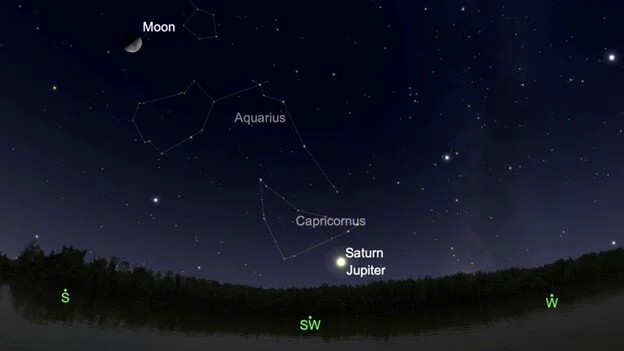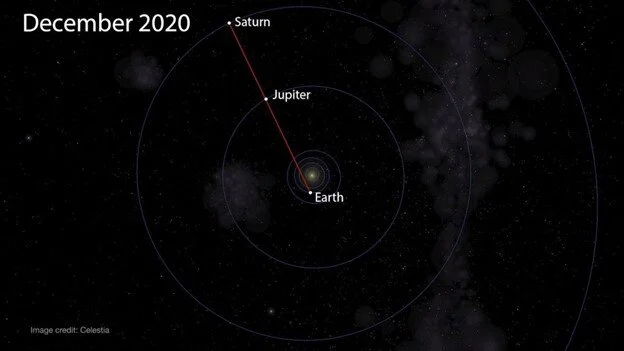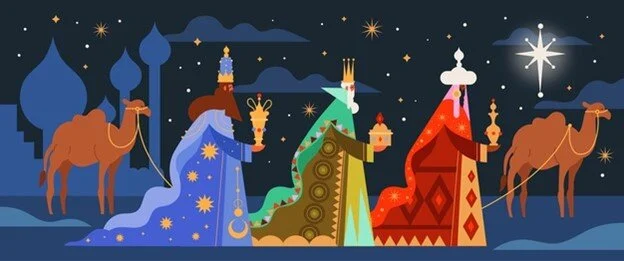The Star of Bethlehem by William Lama, Ph.D.
The Star of Bethlehem
by William Lama, Ph.D.
Sky map shows where to find Jupiter and Saturn in the southwest just after sunset during the great conjunction on 12/21/20. NASA tips to see Jupiter and Saturn as a 'Christmas Star'
The Winter Solstice, Dec. 21, is the shortest day of the year, Brody and Charlie, our West Highland Terriers, didn’t notice. Their belly-alarms went off like clockwork at 6 AM, despite the darkness. That night, shortly after sunset, they also missed seeing the Christmas Star, a rare and spectacular treat. “For centuries, there have been a number of theories regarding the mystical star in the East that led the Magi to the birthplace of Jesus Christ. Michael R. Molnar, in his book, The Star of Bethlehem: The Legacy of the Magi, suggests the theory of conjunction could account for the presence of the star.” The “Great Conjunction”- Jupiter and Saturn take Center Stage in a Holiday Spectacular by Steve Tabor — Palos Verdes Pulse
I’d like to tell you how it works, celestially speaking, in the spirit of Physics for Poets. Physics for Poets by William Lama Ph.D. — Palos Verdes Pulse
The fool on the hill
Sees the sun going down
And the eyes in his head
See the world spinning round
Lennon-McCartney, 1967
A “conjunction” is the lining-up of three planets, a particular case of “syzygy” - a roughly straight-line configuration of three or more celestial bodies. (Wikipedia) The following figure illustrates the conjunction of Earth, Jupiter and Saturn in Dec. 2020.
Having noted the planetary conjunction in Dec. 2020, it’s natural to ask when the next will happen. Can we see one every year around Christmas? To figure that out we need to know a bit about the planets. The orbital period of Jupiter is 12 Earth years while the period of Saturn is longer, 29 years. On Dec 21 Jupiter rushed ahead of Saturn and it will complete an entire revolution (360 degrees) in 12 years while Saturn is only 12/29 = 41% around its orbit. Now I would tell my Physics for Poets classes to make reasonable simplifying assumptions. In this problem assume that the planetary orbits are circles, that the Earth is near the center of the circle and that the planetary speeds are constant. Thus we can write simple equations for the angles traversed by the planets in the time T.
Let Ɵ = Jupiter angle, J = Jupiter period, φ = Saturn angle and S = Saturn period. Then in time T,
Ɵ = (T/J) x 360 and φ = (T/S) x 360
Note Ɵ = φ at T = 0 on Dec. 21, 2020. Before Saturn makes a complete trip Jupiter will lap it, but when? At that time Ɵ = φ + 360, or
(T/J) x 360 = (T/S) x 360 + 360
My Physics for Poets students could solve this simple algebraic expression for the time T.
T = JS/(S – J)
This is a general equation for predicting conjunctions of the Earth and any other two planets farther from the Sun. For example J, S could be Mars, Neptune. For Jupiter and Saturn we have
T = (12x29)/ (29 – 12)
T = 20 years
Thus, in the year 2040 there will be another conjunction of Jupiter and Saturn. The Christmas Star will be seen again.
The Star of Bethlehem
Looking back two millennia, was the “Star of Bethlehem” a conjunction like the one we saw in Dec. 2020?
Remarkably, in the year 7 BC Jupiter and Saturn met not once but three times. The first conjunction on May 29 was visible in the East before sunrise and could have started the Magi on their way to Bethlehem. The second conjunction on Sept. 30 may have strengthed their resolve, while the conjunction on Dec. 5 occurred just as they arrived in Judea to meet with King Herod, who sent them on to Bethlehem to "go and search diligently for the young child." https://www.space.com/great-conjunction-jupiter-saturn-2020-fun-facts
The first conjunction occurred when Jupiter caught up with Saturn on May 29. Shortly after, Jupiter appeared from Earth to go backwards (“retrograde” motion) due to the faster rotation of the Earth, and passed Saturn again on Sept. 30. When seen again from Earth, Jupiter was moving in its normal counterclockwise direction until it passed Saturn again on Dec. 5. Jupiter pacing back-and-forth with Saturn would certainly have been looked upon as a miracle. For an animation of this remarkable triple conjunction see: A Brief History of Great Conjunctions - YouTube
Triple conjunctions were first explained by the great Kepler who attached religious significance to the heavenly events. Kepler proposed that triple conjunctions astronomically coincide with the approach of climacterics in human affairs: the revelation of Adam, the Deluge, the birth of Moses, the birth of Christ and the birth of Charlemagne. Kepler also predicted future events. Regarding the triple conjunction expected about the year 2400, he wondered: “Where shall we be then, and our now most flourishing Germany? If indeed the world itself will then be in existence.” Johannes Kepler, Epitome of Copernican Astronomy, Vol. VI (1621)
When thinking about planetary conjunctions I am reminded of a passage from Chesterton: “There is nothing that really indicates a subtle and in the true sense a superior mind so much as this power of comparing a lower thing (Earth) with a higher (Jupiter) and yet that higher with a higher still (Saturn).” G. K. Chesterton, The Everlasting Man.
Superior minds; I like the sound of that. I’m not so sure about Brody and Charlie. Then again, who is that guy walking behind them attending to their business?
Dr. William Lama has a PhD in physics from the University of Rochester. Taught physics in college and worked at Xerox as a principle scientist and engineering manager. Upon retiring, joined the PVIC docents; served on the board of the RPV Council of Home Owners Associations; served as a PV Library trustee for eight years; served on the PV school district Measure M oversight committee; was president of the Malaga Cove Homeowner's Association. Writes about science, technology and politics, mostly for his friends.
email: wlama@outlook.com




